Abstract
This study examined the determinants of blood lead (BPb) in 513 pregnant women in Mexico City: 311 from public hospital prenatal clinics, representing primarily women of low socioeconomic status (SES), and 202 from private hospitals, primarily women of high SES. Overall, BPb levels ranged from 1.38 to 29 micrograms/dl, with geometric means of 6.7 and 11.12 micrograms/dl for women from private and public hospitals, respectively. The crude geometric means difference obtained by t-test was 4.42 (p < 0.001). BPb was measured from January 1994 to August 1995 and showed higher levels during fall and winter and lower levels during spring and summer. The main BPb determinants were the use of lead-glazed ceramics in women from public hospitals and season of the year in women from private hospitals. Consumption of tortillas (corn bread rich in calcium) decreased BPb levels in the lower SES group, but the relationship was not statistically significant (p > 0.05). Consumption of milk products significantly (p < 0.05) reduced BPb levels in the higher SES group. In 112 women whose diets were deficient in calcium, taking calcium supplements lowered their blood lead levels about 7 micrograms/dl. A predictive model fitted to these data, using the strongest predictors plus gestational age, showed a difference of 14 micrograms/dl between the best and worst scenarios in women from public hospitals. Avoiding use of lead-glazed ceramics, consuming diets rich in calcium, and, if needed, taking calcium supplements, would be expected to result in substantial lowering of BPb, especially in pregnant women of low socioeconomic status.
Full text
PDF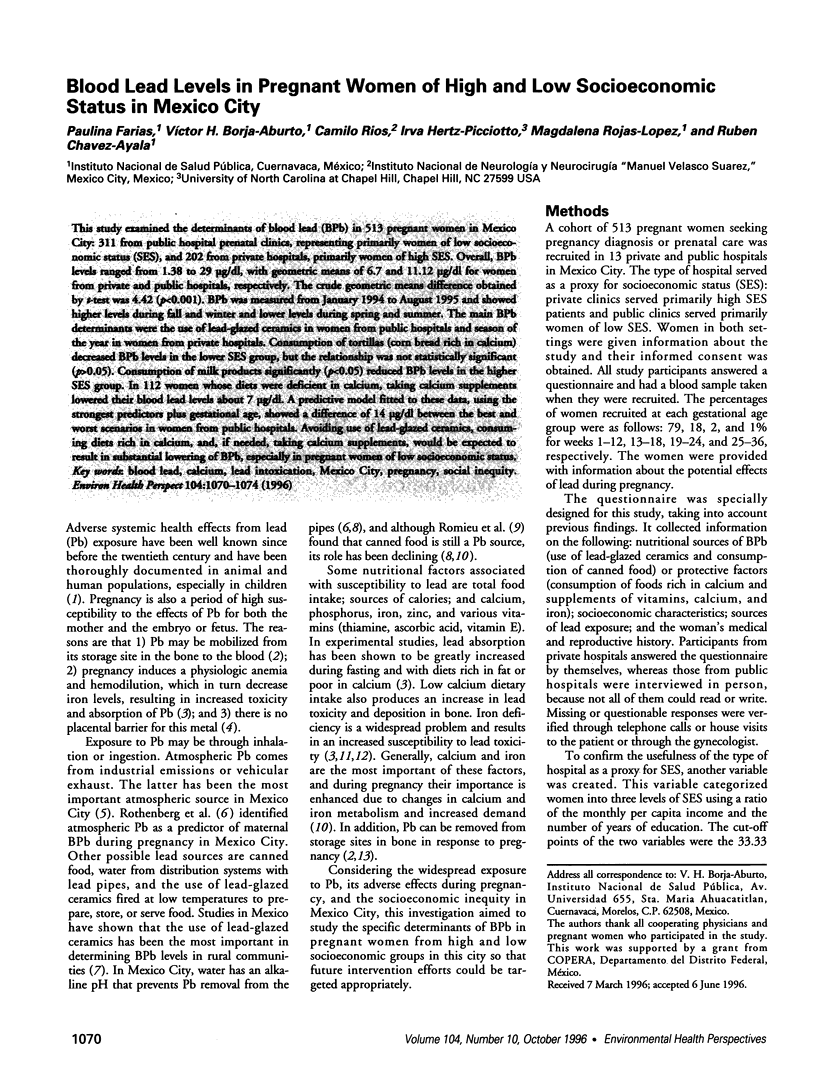
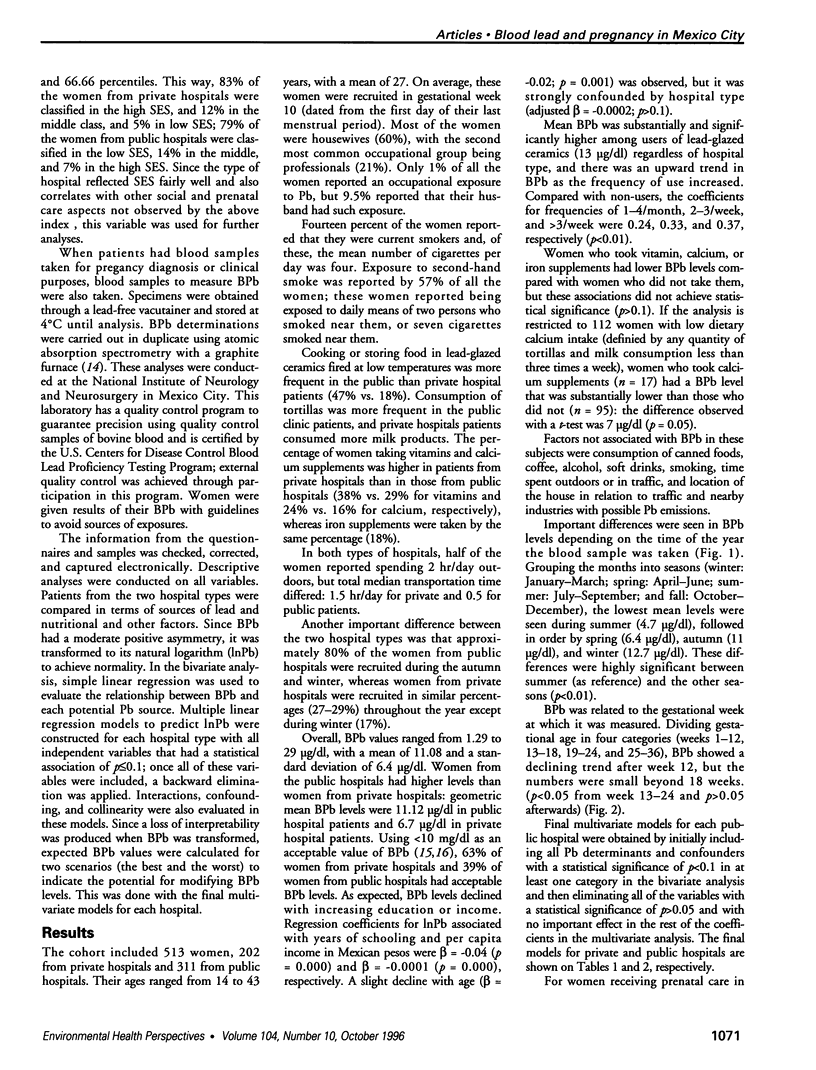
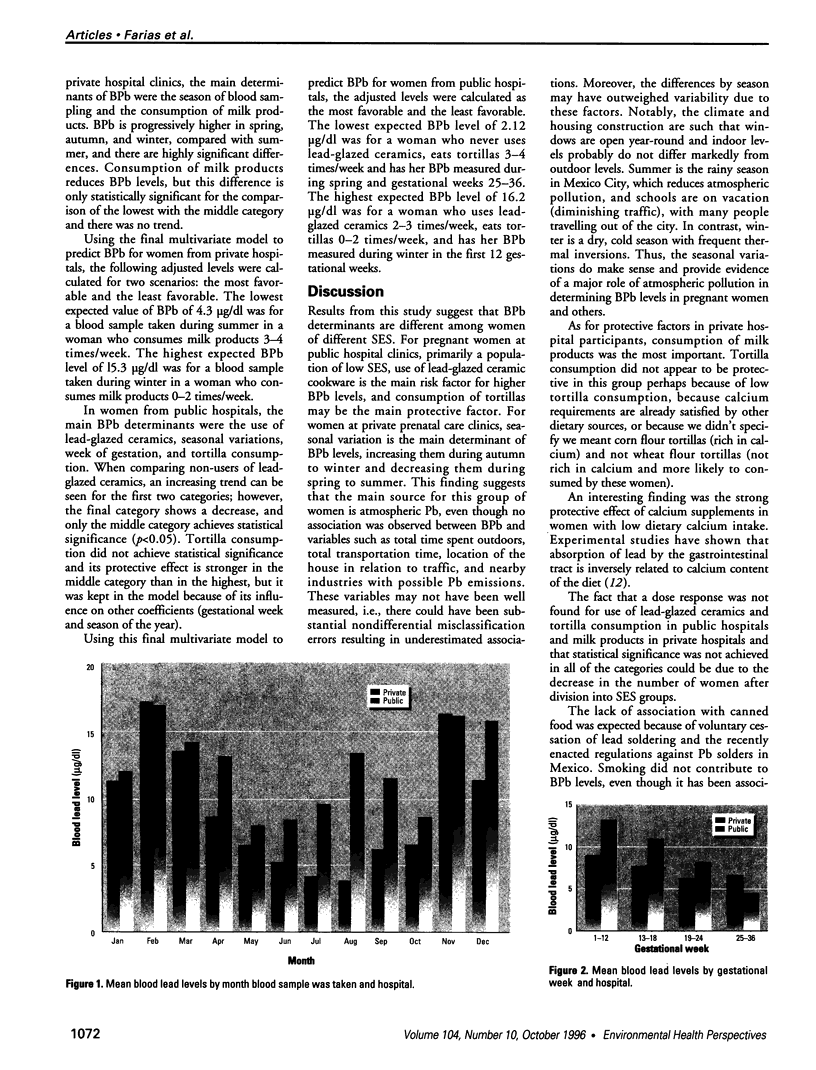
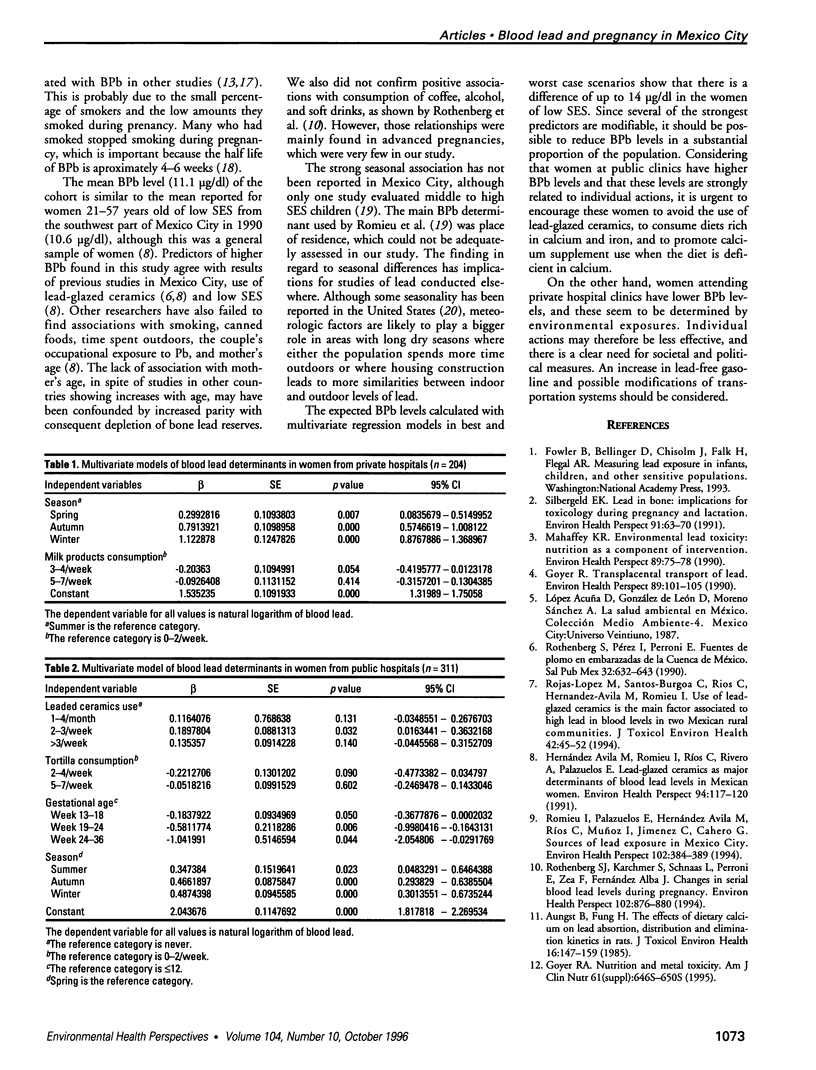
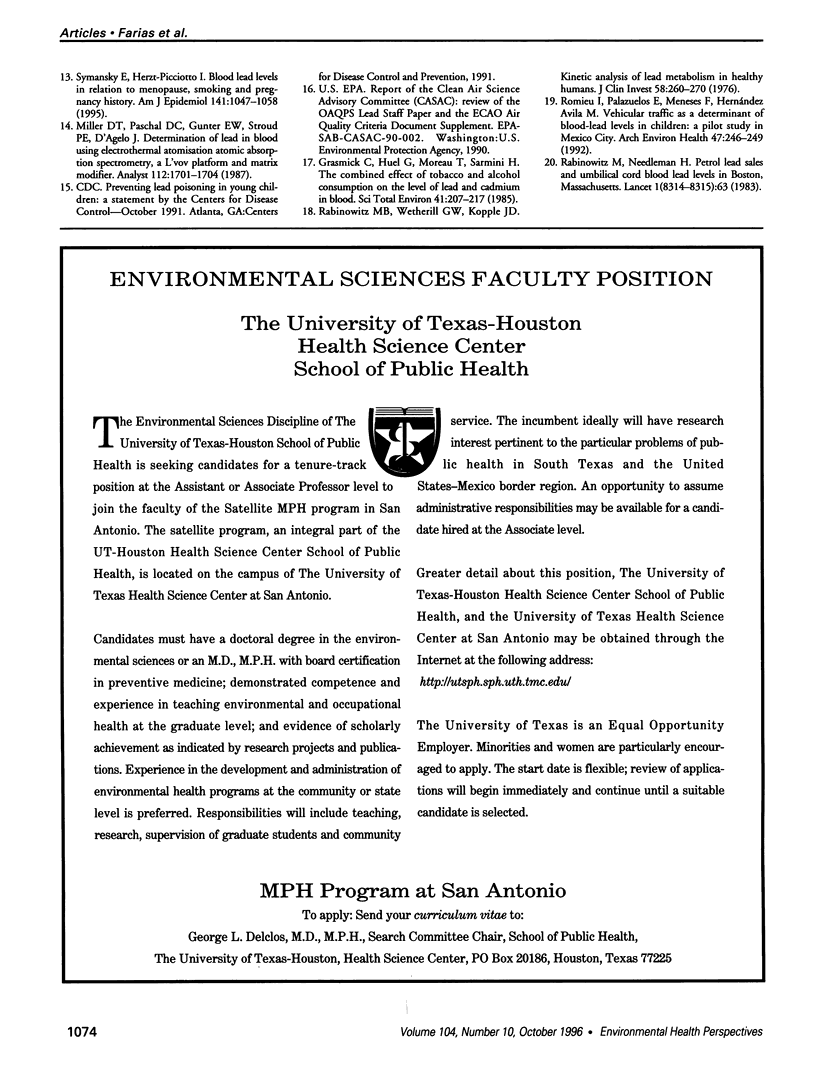
Images in this article
Selected References
These references are in PubMed. This may not be the complete list of references from this article.
- Aungst B. J., Fung H. L. The effects of dietary calcium on lead absorption, distribution, and elimination kinetics in rats. J Toxicol Environ Health. 1985;16(1):147–159. doi: 10.1080/15287398509530726. [DOI] [PubMed] [Google Scholar]
- Goyer R. A. Nutrition and metal toxicity. Am J Clin Nutr. 1995 Mar;61(3 Suppl):646S–650S. doi: 10.1093/ajcn/61.3.646S. [DOI] [PubMed] [Google Scholar]
- Goyer R. A. Transplacental transport of lead. Environ Health Perspect. 1990 Nov;89:101–105. doi: 10.1289/ehp.9089101. [DOI] [PMC free article] [PubMed] [Google Scholar]
- Grasmick C., Huel G., Moreau T., Sarmini H. The combined effect of tobacco and alcohol consumption on the level of lead and cadmium in blood. Sci Total Environ. 1985 Mar 1;41(3):207–217. doi: 10.1016/0048-9697(85)90142-1. [DOI] [PubMed] [Google Scholar]
- Hernandez Avila M., Romieu I., Rios C., Rivero A., Palazuelos E. Lead-glazed ceramics as major determinants of blood lead levels in Mexican women. Environ Health Perspect. 1991 Aug;94:117–120. doi: 10.1289/ehp.94-1567967. [DOI] [PMC free article] [PubMed] [Google Scholar]
- Mahaffey K. R. Environmental lead toxicity: nutrition as a component of intervention. Environ Health Perspect. 1990 Nov;89:75–78. doi: 10.1289/ehp.908975. [DOI] [PMC free article] [PubMed] [Google Scholar]
- Miller D. T., Paschal D. C., Gunter E. W., Stroud P. E., D'Angelo J. Determination of lead in blood using electrothermal atomisation atomic absorption spectrometry with a L'vov platform and matrix modifier. Analyst. 1987 Dec;112(12):1701–1704. doi: 10.1039/an9871201701. [DOI] [PubMed] [Google Scholar]
- Rabinowitz M. B., Wetherill G. W., Kopple J. D. Kinetic analysis of lead metabolism in healthy humans. J Clin Invest. 1976 Aug;58(2):260–270. doi: 10.1172/JCI108467. [DOI] [PMC free article] [PubMed] [Google Scholar]
- Rabinowitz M., Needleman H. L. Petrol lead sales and umbilical cord blood lead levels in Boston, Massachusetts. Lancet. 1983 Jan 1;1(8314-5):63–63. doi: 10.1016/s0140-6736(83)91590-8. [DOI] [PubMed] [Google Scholar]
- Rojas-López M., Santos-Burgoa C., Ríos C., Hernández-Avila M., Romieu I. Use of lead-glazed ceramics is the main factor associated to high lead in blood levels in two Mexican rural communities. J Toxicol Environ Health. 1994 May;42(1):45–52. doi: 10.1080/15287399409531862. [DOI] [PubMed] [Google Scholar]
- Romieu I., Palazuelos E., Hernandez Avila M., Rios C., Muñoz I., Jimenez C., Cahero G. Sources of lead exposure in Mexico City. Environ Health Perspect. 1994 Apr;102(4):384–389. doi: 10.1289/ehp.94102384. [DOI] [PMC free article] [PubMed] [Google Scholar]
- Romieu I., Palazuelos E., Meneses F., Hernandez-Avila M. Vehicular traffic as a determinant of blood-lead levels in children: a pilot study in Mexico City. Arch Environ Health. 1992 Jul-Aug;47(4):246–249. doi: 10.1080/00039896.1992.9938356. [DOI] [PubMed] [Google Scholar]
- Rothenberg S. J., Karchmer S., Schnaas L., Perroni E., Zea F., Fernández Alba J. Changes in serial blood lead levels during pregnancy. Environ Health Perspect. 1994 Oct;102(10):876–880. doi: 10.1289/ehp.94102876. [DOI] [PMC free article] [PubMed] [Google Scholar]
- Rothenberg S. J., Pérez Guerrero I. A., Perroni Hernández E., Schnaas Arrieta L., Cansino Ortiz S., Suro Cárcamo D., Flores Ortega J., Karchmer S. Fuentes de plomo en embarazadas de la Cuenca de México. Salud Publica Mex. 1990 Nov-Dec;32(6):632–643. [PubMed] [Google Scholar]
- Silbergeld E. K. Lead in bone: implications for toxicology during pregnancy and lactation. Environ Health Perspect. 1991 Feb;91:63–70. doi: 10.1289/ehp.919163. [DOI] [PMC free article] [PubMed] [Google Scholar]
- Symanski E., Hertz-Picciotto I. Blood lead levels in relation to menopause, smoking, and pregnancy history. Am J Epidemiol. 1995 Jun 1;141(11):1047–1058. doi: 10.1093/oxfordjournals.aje.a117369. [DOI] [PubMed] [Google Scholar]




